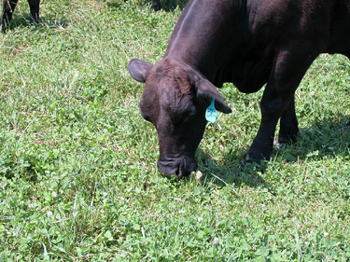
White Clover Basics
White clover (Trifolium repens L.) is a cool season perennial legume of Mediterranean origin. White clover has been used as a forage in North America since Colonial times. Benjamin Franklin noted its prevalence in cleared and disturbed land as early as 1746. There are many reasons for white clover's popularity among forage producers. Several of the more common reasons are listed below.
White Clover Uses
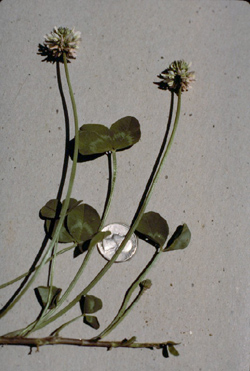 Figure 1. White clover has "runners" or stolons that provide a secondary root system and energy storage for regrowth and grazing tolerance.
Figure 1. White clover has "runners" or stolons that provide a secondary root system and energy storage for regrowth and grazing tolerance.Pasture Renovation
White clover has a creeping growth habit and spreads with stolons or "runners" (Figure 1) above the soil with adventitious roots forming at each node. This type of growth pattern is one reason for the excellent grazing tolerance of white clover. Livestock only consume the leaves and flowers of the plant, reducing plant injury and promoting timely regrowth. White clover also helps to fill voids in the sward, which would otherwise be filled with weedy species.
Improved Forage Distribution
Because white clover fills voids in grass stands, forage yields are often increased, particularly when tall fescue and orchardgrass stands have thinned. In addition, white clover is a cool season forage, so it can improve (at least as an annual) the forage distribution and grazing season of warm season pastures like bermudagrass and bahiagrass. White clover is generally productive in late winter to late spring and mid-fall to mid-winter when warm season perennials are not productive or have low nutritive value.
Improved Diet Quality and Animal Performance
Because of the high quality of white clover, it is well suited for use as a complimentary forage in cool season perennials like tall fescue and orchardgrass. Table 1 lists the approximate nutrient content of grazed grass and clover plant species.
| Table 1. Approximate nutrient content (% dry matter) of some common grass and clover pasture plants. (Hoveland, 2000) | |||||
| Crude Protein | TDN | Calcium | Phosphorus | Magnesium | |
| Species | ---------- | ---------- | ---%--- | ---------- | ---------- |
| White clover | 25 | 80 | 1.5 | 0.4 | 0.4 |
| Red clover | 20 | 70 | 1.5 | 0.4 | 0.4 |
| Annual ryegrass | 20 | 68 | 0.5 | 0.3 | 0.2 |
| Orchardgrass | 15 | 65 | 0.3 | 0.3 | 0.2 |
| Tall fescue | 13 | 62 | 0.3 | 0.3 | 0.2 |
| Bermudagrass | 10 | 54 | 0.3 | 0.2 | 0.2 |
The high total digestible nutrient (TDN) and crude protein content of white clover can increase animal performance on pasture simply due to increased nutrient density. In addition, the higher level of magnesium in clovers decreases the potential risk of grass tetany in the spring months. The majority of tall fescue in Georgia is infected with a toxin-producing fungus that diminishes animal performance (see UGA Cooperative Extension publication Circular 861: Novel Endophyte-Infected Tall Fescue). White clover interseeded into toxic tall fescue pastures can reduce intake of these toxins and improve animal performance. Animals will selectively graze the clover, thereby reducing consumption of the toxic grass. This, in combination with the improved diet quality of the clover, greatly improves performance of animals grazing toxic tall fescue (Table 2).
| Table 2. Beef steer performance as affected by white clover in endophyte-infected tall fescue. (Hoveland et al., 1981) | ||
| Average Daily Gain (lb) | Gain/Acre (lb) | |
| Infected tall fescue | 1.06 | 374 |
| Infected tall fescue + clover | 1.53 | 582 |
White clover can also be seeded into bermudagrass pastures on favorable soils to improve nutrient content of the sward. New grazing-tolerant white clover varieties have persisted for three years under grazing in bermudagrass sod in trials near Calhoun Georgia.
Provide Nitrogen to Companion Grasses
In addition to improving animal performance, a frequently mentioned benefit of including clover in pastures is nitrogen fixation. The earth's atmosphere is made up of about 80 percent nitrogen; this nitrogen is not, however, in a form plants can utilize. Nitrogen is "fixed" in clovers through a symbiotic relationship with Rhizobium bacteria that infects the plant's roots. The plant provides energy for the bacteria, and bacteria provide the "machinery" necessary to convert atmospheric nitrogen into a form available to plants. Nitrogen fixation is one of many economically important features of clover, particularly when clover represents a substantial proportion of available forage. A vigorous stand of white clover will fix 100-150 pounds of nitrogen per year depending on soil and growing conditions (Table 3). At fertilizer nitrogen prices of $0.60 per pound, this translates to $60-$90 per acre. The economic value of nitrogen fixation alone should more than pay for seed and establishment expenses.
| Table 3. Approximate pounds of nitrogen annually fixed per acre by various legumes. (Don Ball, Auburn University) | ||
| Legume Species | Annual Pounds N/Acre | N Value at $0.60/lb |
| Alfalfa | 200-300 | $120-180 |
| Red clover | 100-200 | $60-120 |
| White clover | 100-150 | $60-90 |
| Annual clovers (arrowleaf, crimson, etc.) | 50-150 | $30-90 |
Direct benefits of nitrogen fixation are realized almost exclusively by clover plants. Studies have shown that mixed grass and clover stands can produce forage yields equivalent to those of nitrogen fertilized grass stands. In the clover-containing system, overall grass yields decrease, but clover yields offset these decreases. In addition to clover plants supplying forage without nitrogen fertilization, overall forage quality available to animals is higher in pastures containing clover.
Most people envision a "pipeline" that transports nitrogen directly from clover to grass. Unfortunately almost no nitrogen is contributed to grasses in this way. Essentially all nitrogen supplied to grasses from clover is indirect. Because of this indirect route, nitrogen from clover root nodules is not immediately available to companion grasses. Root nodules must decompose and nitrogen must be converted into a form available to plants. This conversion or "mineralization" releases nitrogen slowly, much like a time release fertilizer. This slow, steady nitrogen supply from a healthy stand of white clover can keep perennial grasses green and productive through the growing season.
Fixed nitrogen from clovers is also supplied to grasses via grazing animals. Nitrogen in consumed high quality clover plants that is not digested or deposited in the animal, returns to the pasture as dung or urine and can be a valuable source of fertilizer for grasses.
Variety Selection
White Clover Types
White clovers are frequently classified into one of three morphological groups: small, intermediate and large. Small types seldom exceed 3 inches in height and are found in closely grazed areas or lawns. These clovers have low productivity and contribute little to grazing animal production. Large or ladino white clovers are larger leafed, later blooming and more upright growing than either small or intermediate white clover types. Under optimal fertility and management, ladino white clovers are more productive than other white clover types. However, ladino clovers are not dependable reseeders and have fewer stolons and leaves close to ground level. Because of these reasons, ladino clovers have lower grazing persistence. Intermediate clovers are exactly as their name implies: intermediate. Flowering period and leaf size fall between small and large-type white clovers. Intermediate types typically reseed more dependably than ladinos, possess many stolons and leaves at ground level, and produce more forage than small types. Because of these traits, intermediate types of white clover persist well in grazing situations.
Factors to Consider When Choosing a White Clover Variety
Many commercial varieties of white clover are available on the market. It is recommended that you choose a good yielding, persistent and disease resistant variety that is well suited to your growing environment. While varieties that yield high amounts of forage are attractive, producers must be able to effectively harvest these yields. In contrast, low yielding clovers (for example, "white dutch" or common cultivars) do not typically furnish adequate amounts of high quality forage in many Georgia environments.
Most cultivars are susceptible to viruses that decrease productivity and shorten stand life. Recently, grazing-persistent varieties have been developed that produce good yields, have excellent tolerance to defoliation, and survive for many years. Consider all these factors when selecting a variety for establishment.
Most commercially available white clover varieties are the large or ladino type. Most available ladino varieties have performed similarly in tests across north Georgia. Regal is a variety developed in Alabama that has consistently yielded well in the Southeast. Regal seed are readily available and well adapted statewide. Osceola is a Florida developed variety which is also a good performer. Colt and Will also produce good yields and will typically persist for two to three years under good fertility and proper grazing management. Ivory and Tripoli typically yield and perform well in Georgia for one to two years, but are probably the least persistent of the ladino types in this area.
Two white clover varieties, Durana and Patriot, were developed and released by Dr. Joe Bouton at the University of Georgia in collaboration with Dr. Derek Woodfield and Dr. John Caradus, AgResearch, New Zealand. These two newly developed white clovers persist well in grazed Georgia environments and offer excellent potential to improve both animal performance and pasture quality.
Durana and Patriot Development
To improve grazing tolerance of white clovers, Dr. Bouton collected plants that had survived several hot, dry summers from several locations in Georgia. These plants, called native ecotypes, were dug from pastures where clover had not been planted for many years. After transplanting offspring of these ecotypes into the harsh environment of the Department of Animal and Dairy Science's Beef Research Unit near Eatonton, Georgia, plants were subjected to heavy, continuous grazing with grass competition. Productive survivors were crossed, and a promising entry (ultimately named Durana) was increased for further development.
Durana has smaller leaves than ladino clovers but produces many more "runners" or stolons, which allows for aggressive spreading and excellent grazing tolerance. Durana flowers profusely for long periods, which may make it a more dependable reseeder. Parent material that gave rise to Durana was also crossed with a virus-resistant ladino clover. The product of this cross, named Patriot, is also commercially available.
Small-plot testing of Durana under clipping at four-week intervals indicates it is highly persistent but slightly lower yielding than ladino-type white clovers during the establishment year (Tables 4 and 5). Even though Durana yields are lower than ladino varieties during establishment, Durana's persistence overcomes yield reductions after two to three years when ladino stands ultimately fail in grass pastures. Patriot yield is more like the ladino type (Table 4), but its persistence is superior (Table 5). Note that clipping trials likely overestimate the persistence of Regal ladino clover. Patriot's increased yields make it ideal for producers practicing rotational grazing who can effectively harvest this forage.
| Table 4. Clipped dry forage yields of white clover varieties near Athens, Ga. Established Oct. 29, 1999. (Hoveland and Durham, unpublished data) | ||
| Entry | Establishment Year, 2000, Yield (lb/Acre) | 2000-2001 Average (lb/Acre) |
| Regal | 4,172 | 3,969 |
| Durana | 3,218 | 3,834 |
| Patriot | 3,816 | 4,180 |
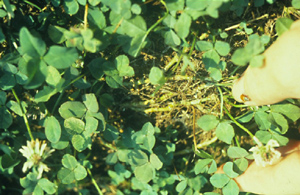 Figure 2. Dense stolons of Durana white clover provide energy reserves for regrowth and survival under heavy grazing.
Figure 2. Dense stolons of Durana white clover provide energy reserves for regrowth and survival under heavy grazing.Grazing persistence is a far better predictor of clover performance than yield clipping trials because grazed clovers are frequently defoliated and subjected to repeated hoof abuse. Table 5 is derived from a study conducted at the Northwest Georgia Branch Station by Dr. Carl Hoveland and Greg Durham. In this study, Durana, Patriot and Regal clovers were fall planted in bermudagrass sod and continuously grazed. Ground coverage of all clover entries was similar at the beginning of the study. After one year of grazing, basal coverage of Regal ladino clover was significantly less than that of Durana or Patriot. This is important because basal coverage provides energy storage and growing points for good regrowth and survival of Durana and Patriot (Figure 2).
| Table 5. Percent basal coverage within row of white clover entries continuously grazed in bermudagrass sod. Planted Oct. 1, 1999, at the Northwest Georgia Branch Station. | ||
| Entry | Percent basal cover Mar. 31, 2000 |
Percent basal cover Jan. 31, 2002 |
| Regal | 77 | 6 |
| Durana | 90 | 65 |
| Patriot | 85 | 75 |
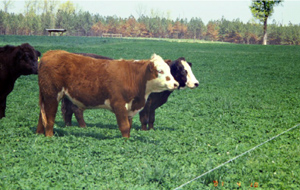 Figure 3. Beef steers grazing tall fescue overseeded with Durana white clover. As of 2003, this clover had persisted for five years at the Animal and Dairy Science's Beef Research Unit near Eatonton, GA. Approximately 45 percent white clover and 55 percent tall fescue on dry matter basis.
Figure 3. Beef steers grazing tall fescue overseeded with Durana white clover. As of 2003, this clover had persisted for five years at the Animal and Dairy Science's Beef Research Unit near Eatonton, GA. Approximately 45 percent white clover and 55 percent tall fescue on dry matter basis.Performance of stocker steers grazing four-year-old pastures near Eatonton also demonstrates the benefits of Durana white clover persistence (Table 6). In this study, steers grazing toxic tall fescue and Durana gained almost 300 percent more pounds per day and greater than 100 pounds more per acre than nitrogen fertilized toxic tall fescue. Regal ladino white clover had essentially failed as indicated by low average daily gains (no clover forage to offset intake of toxic tall fescue) and low gain per acre (low nitrogen fixation). We continued grazing the excellent Durana pastures (Figure 3) while Regal stands had to be reseeded. Tall fescue stands overseeded with Patriot at the Northwest Georgia Station have also persisted well and improved performance of animals grazing toxic tall fescue.
| Table 6. Beef steer performance on tall fescue pastures planted fall 1998 with Durana white vs. Regal ladino clover in central Georgia, fourth year after establishment, Mar. 28 to Jun. 14, 2002. (Bouton, Andrae and Hoveland, 2003) | ||
| Pasture | Average Daily Gain (lb/d) | Pounds Gained per Acre |
| Toxic tall fescue + N | 0.60 | 187 |
| Toxic tall fescue + Durana | 1.79 | 296 |
| Toxic tall fescue + Regal | 0.89 | 136 |
| Note: Paddocks were not grazed the first year due to extreme drought. | ||
Establishment
Soil and Site Requirements
White clover has several soil nutrient requirements for satisfactory establishment and growth. Soil acidity influences availability of several nutrients and decreases survival of Rhizobium bacteria, which are necessary for nitrogen fixation. Soil should be limed to a minimum pH of 6.0. Clovers are highly responsive to potassium and phosphate, so adequate amounts of these nutrients are critical for establishment, persistence and productivity. Below optimal levels of soil P and K are responsible for many clover failures in pastures. White clover performs well on wet soils and persists far better on these soils than red clover. White clover will also perform well on lighter soils, but you should avoid planting in deep sands.
Include the proper Rhizobium inoculum (type B) at planting if white clover has not grown in the field for several years. Most clover seed is pre-inoculated, but check the seed tag to ensure that inoculum is present and has not expired. Inoculum is inexpensive (about 10 cents per acre) and should be included in all clover plantings to ensure that 100-150 pounds of nitrogen is fixed annually.
Also be sure that no herbicide with residual broad-leaf activity has been applied to the field in the year prior to seeding. 2,4-D has only a short residual activity (two to three weeks) and should not pose many problems, but dicamba (Banvel or Weedmaster) has a 120 day residual activity and picloram (Grazon P+D) has residual activity up to one year after spraying.
Establishing New Stands of White Clover And Cool Season Grass Simultaneously
White clover seedlings can be extremely competitive with tall fescue and orchardgrass seedlings, so establishment mixtures should be planted with caution. Because of the low, creeping growth habit of white clover, seedling grasses can be lost from "smothering." Paddocks may need to be flash grazed (allowing animals access for a short period of time to remove excess growth) during establishment to minimize clover competition. Delaying clover seeding until after perennial grasses are well established is a preferable practice. Delaying clover establishment allows broadleaf weeds to be controlled with herbicides while the cool season grass is establishing.
Establishing White Clover in Existing Pastures
The 2- to 3-pound per acre seeding rate of white clover appears low for a simple reasonâ??seeds are tiny! On average there are more than 750,000 white clover seeds per pound. For a relative comparison, there are only 11,000 wheat seed per pound. Because of this small size, clover seed must be planted at the proper depth for good emergence. Seeding depth should not exceed 0.25-0.5 inch. If seeds are planted too deep, poor germination will occur and may lead to an establishment failure.

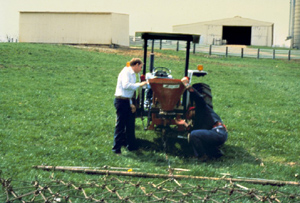 Figure 4. White clover can be established by sod-seeding with a no-till drill (top), broadcasting and dragging (bottom) or by broadcasting and trampling seed in with temporarily heavy stocking rates.
Figure 4. White clover can be established by sod-seeding with a no-till drill (top), broadcasting and dragging (bottom) or by broadcasting and trampling seed in with temporarily heavy stocking rates.It is difficult to adjust a standard grain drill to accurately deliver appropriate seed amounts at the proper rate and depth. Use drills with seed boxes designed for small seed metering and delivery (Figure 4). If planting with a no-till drill, use the coulters or disc openers to slice existing sod and lightly scratch the soil surface. Use press wheels to establish good seed-soil contact at a shallow depth.
Because of the shallow seed depth requirements of clover, seed can be broadcast onto closely grazed sod during late winter and incorporated into soil surface by (1) dragging, (2) hoof treading with temporarily high stocking rates, or (3) frost. Using a chain drag is an inexpensive and rapid method that can be used either simultaneously with broadcasting or in two separate passes. Using animal hoof action is a cheap (but less dependable) alternative to a no-till drill. Frost can also be used to deliver clover seed to an ideal planting depth in far north Georgia. Freezing forms a "honeycomb" appearance on the soil and allows legume seeds to settle just below the surface after several freeze-thaw cycles. Broadcast seeding is more effective in February than in fall months, so first-year forage production will likely be decreased when broadcasting. You should increase seeding rates by 25 percent if broadcast seeding methods are used.
Manage Pasture to Favor Clover Seedlings During Establishment
Clover seedling growth must be favored when planted in competitive established grasses like tall fescue or bermudagrass. Excess competition from companion grass is probably the most common reason for clover establishment failures. Remember that during establishment, grass is the enemy! Consider any practice favoring clover seedlings and penalizing existing grass (without completely killing it). Several management options are available to aid clover establishment.
Remove excess forage and thatch just prior to seeding.
This will prevent shading, improve seed-soil contact and help clover seedlings survive. Ideally, excess forage should be removed with heavy grazing, but haying is also be an acceptable alternative.
"Chemical frosts" will suppress autumn tall fescue growth and favor clovers at establishment.
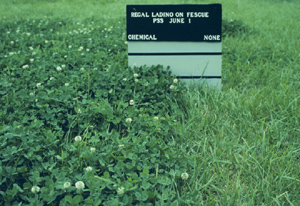 Figure 5. Regal white clover established in a dense stand of tall fescue with a "chemical frost" of paraquat to suppress grass (left) and without suppression (right).
Figure 5. Regal white clover established in a dense stand of tall fescue with a "chemical frost" of paraquat to suppress grass (left) and without suppression (right).These chemical frosts are created by spraying low rates of Gramoxone onto well established tall fescue before clover seeding to suppress grass growth. Follow label requirements closely and calibrate the sprayer, as tall fescue can be excessively thinned or killed with improper herbicide rates or under environmentally stressful conditions. In many stands of tall fescue, clover can be established without chemical suppression. However, if tall fescue sod is dense, light applications of Gramoxone are helpful in suppressing sod and dependably establishing white clover (Figure 5). Banded applications of Gramoxone that treat approximately 40 percent of tall fescue can also be used to help minimize grass injury and allow good clover establishment.
When establishing white clover in bermudagrass or other perennial warm season grasses, delay planting until after a killing frost to minimize grass competition.
Plant clover into closely grazed sod in fall or early winter after warm season grasses are dormant to allow adequate clover establishment before green up. Spring plantings should be avoided in the Coastal Plain and Piedmont because of heavy grass competition with clover seedlings.
Manage grazing during establishment.
At establishment, white clover produces a primary stem and root. The primary stem produces runners, which allows the plant to spread. Like bermudagrass, these stolons provide a secondary root system and allow white clover to perenniate. The primary root of white clover will eventually die, so it is critical to allow secondary root growth to occur soon after establishment. It is equally important to minimize grass shading and allow sunlight to reach the clover seedlings. Therefore, a balancing act must take place. Competing grass must be removed with minimal grazing damage to young clover seedlings. Flash grazing is a useful tool for balancing this grass/legume relationship. Once the white clover runners have rooted, it is safe to graze.
Consider fertilizer and poultry litter effects on seedlings.
During the first year of clover establishment, nitrogen fixed by clover is not mineralized and is unavailable to grasses. Avoid applications of nitrogen fertilizer or poultry litter while clover is establishing as this will favor grass growth and increase competition. Light nitrogen applications (30-40 pounds per acre) should only be applied when grass production (1) is desperately needed and (2) can be reliably and effectively removed with grazing to prevent shading of clover seedlings. If nitrogen is added to these stands, pastures must be grazed in a controlled manner to prevent grasses from out-competing clover. Conduct grazing in a manner that avoids or minimizes clover injury. If controlled grazing methods are not feasible, do not apply nitrogen during the establishment year. Adequate levels of phosphate and potash, on the other hand, are necessary for competitive and productive clover plants. It is critical to conduct a soil test and, if necessary, apply these nutrients for successful clover establishment and persistence.
Scout for insect damage in early fall.
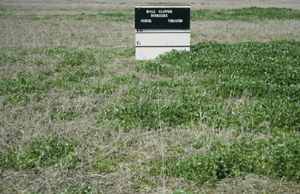 Figure 6. A stand of ball clover that was treated with insecticide (right) and not treated (left) at establishment to curtail insect damage. White clover would respond similarly when insect pressure is present in the fall.
Figure 6. A stand of ball clover that was treated with insecticide (right) and not treated (left) at establishment to curtail insect damage. White clover would respond similarly when insect pressure is present in the fall.Insects can be a serious pest when planting legumes in the fall. Pygmy crickets can quickly and completely eliminate newly emerged seedlings (Figure 6). Scout fields closely and be ready to apply an appropriate insecticide if necessary. Crickets may be difficult to spot, but their presence will be indicated by small circular-shaped bites on clover seedling leaflets. Delaying planting until after a killing frost greatly decreases insect pressure.
Management of Established White Clover
Fertilization
Soil test pastures on alternate years and apply necessary lime, phosphate (P) and potassium (K) to maintain healthy and productive stands. Although P and K are not removed in large amounts under grazing, nutrients can be redistributed to shade, watering and other lounging areas where urine and dung are concentrated. This is
Status and Revision History
Published on Mar 18, 2004
Published on Mar 24, 2009
Published with Full Review on Mar 30, 2012
Published with Minor Revisions on Feb 28, 2016


























































